The Science Teacher: Call for Papers
By sstuckey
Posted on 2017-04-19

The Science Teacher (TST) seeks manuscripts of approximately 2,000 words that describe new and creative ideas for the secondary science classroom. Manuscripts should provide practical activities related to the themes listed below. TST also encourages manuscripts outside of the listed themes. For help, see our author guidelines and annotated sample manuscript.
Forensics: Solving Mysteries Through Science
SUBMISSION DEADLINE: May 1, 2017
Forensic science is both an important part of our criminal justice system and also an avenue for engaging students in scientific inquiry. From the stories of Sherlock Holmes to the popular television drama CSI, the analysis of forensic evidence has fascinated citizens for centuries. By its nature, forensics is an interdisciplinary subject, bringing in modern analytic techniques from chemistry, molecular biology, paleontology, physics, and Earth science. Do you use forensics activities in your classes? Have you found new strategies and engaging activities to teach this fascinating subject or enrich other subject areas? If so, TST wants to hear from you.
Using New Tools to Support Science Learning in a Connected World
SUBMISSION DEADLINE: June 1, 2017
As technology evolves, so do the skills needed for success in the modern world. New tools have radically changed the way we communicate, share information, and collect data. This issue will explore how these new tools can support student learning and create a “connected classroom.” Possible topics include ideas for using:
• social media
• online simulations and virtual field trips
• YouTube, online lectures, virtual learning communities, and flipped classrooms
• strategies to improve critical thinking and digital and media literacy
• probeware and wireless data collection in laboratory and field work
• cloud computing
• modeling
• big data
• mathematics and computational thinking tools
• 3D printers
• new presentation and communication tools
• live webcams
• digital graphics, multimedia, and visualization tools.
Please share your ideas for teaching with new tools.
Innovation
SUBMISSION DEADLINE: July 15, 2017
Innovation is crucial to science and engineering fields and also important in science education. Have you developed an innovative activity, assessment, or teaching strategy? Have you found a creative way to integrate science or engineering innovations in your classes? Share your ideas about using science innovation and innovative teaching methods. Possible ideas might include:
• Creating a new twist on an established activity,
• Integrating 21st-century skills development,
• Using new technologies to support student learning, or
using established technologies in a novel way,
• Incorporating recent scientific research, discoveries, or innovations in your instruction,
• Developing unique student grouping or assessment
methods.
General Topics
SUBMISSION DEADLINE: Ongoing
The Science Teacher seeks general manuscripts across a variety of disciplines. Do you have an article in mind that does not fit with one of TST’s themes? Submit it for review! General articles not targeted to a requested theme are published in every issue. Possible topics include integrating technology, science on a shoestring, innovation, new twists on classic lessons, community collaborations and partnerships, assessment strategies, engineering and the maker movement, and connecting to the Next Generation Science Standards. Don’t limit yourself to these topics. Our readers want to hear about your classroom-tested activities and teaching strategies.
Science for All
SUBMISSION DEADLINE: Ongoing
TST seeks manuscripts for this annual issue devoted to the inclusion of all learners. The issue offers strategies to mitigate academic achievement gaps associated with ethnicity, socioeconomic status, gender, physical disabilities, limited English-language proficiency, learning differences, and even gifted abilities. Please share your ideas for what works in the classroom.
Idea Banks
SUBMISSION DEADLINE: Ongoing
TST is always seeking Idea Banks—short articles of about 1,000 words. If you want to share an experience, activity, or classroom tip but do not think it will work as a feature-length article, consider submitting an Idea Bank.
Commentary
SUBMISSION DEADLINE: Ongoing
Commentaries of approximately 750 words on any secondary education topic are accepted at any time. Do you have thoughts on science education that you would like to share with your peers? Write a Commentary and submit it to TST for review.
Author registration/submission of manuscripts
Get Involved With NSTA!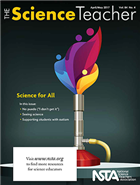
Join NSTA today and receive The Science Teacher,
the peer-reviewed journal just for high school teachers; to write for the journal, see our Author Guidelines, Call for Papers, and annotated sample manuscript; connect on the high school level science teaching list (members can sign up on the list server); or consider joining your peers at future NSTA conferences.

STEM-In-Action at its Best: Students Turn Ideas into Reality
By Korei Martin
Posted on 2017-04-18

Team Crabyotics, 2015 White House Science Fair
When it comes to student-focused STEM projects at Taos Middle/High School, ideas seem limitless.
It all started with information shared from a group of Taos students participating in a STEM demonstration during eCYBERMISSION‘s 2013-2014 National Judging & Educational Event (NJ&EE). The demonstration mentioned the use of Chitosan as a filtration. The students shared this information back in New Mexico with soon-to-be team Crabyotics—Andrea-Chin Lopez, Julia Johnson, Anthony Archuleta, and James Valerio.
This shared-information soon became a bio-filter system community project, which competed in local science fairs, competitions, and of course eCYBERMISSION, which resulted in the team’s STEM-In-Action Grant.
During the 2013-2014 eCYBERMISSION competition, Team Advisor (TA) Laura Tenorio and her team “Crabyotics,” located in New Mexico, developed a bio-filter system that successfully removes antibiotic drugs from drinking water, thus helping to stem the growth of drug-resistant bacteria.
“To this day, if you ask any of them, they still don’t believe it really happened,” said Team Advisor Laura Tenorio. “They are convinced that it was just a dream.”
Three Steps to Turn Your Idea into Reality
Taos is considered a rural area with access to limited resources for major scientific efforts. But at the Middle School’s science lab, commonly referred to as the “The Tyger Lab,” Anthony and Andrea came together with their fellow 9th grade team members James and Julia to research all that was needed to produce Chitosan and then produce a filter.

- In July of 2013, team Crabyotics began to work on their IDEA of making a filter against antibiotics.
- It was then that they DETERMINED that not only could it chemically work in theory, but that this filtration method could also be cost effective.
- This was when they began to think of a business plan, which the group CREATED after their research revealed their filter had potential for a patent.
“eCYBERMISSION completely changed the entire focus of the project, along with the STEM-In-Action Grant,” said Andrea… “Thanks to the grant and our Team Advisor, the project and our futures were invested and encouraged.”
Andrea and TA Laura Tenorio worked together to smooth out the business plan the team started creating. The teams’ main goal was to turn an idea into reality and incorporate into the community.
Of the original STEM-In-Action Grant proposal, the only part that has not been implemented is the Middle School and Community implementation. Actions are currently underway to determine a mass identification of water contaminants. The patent application is ongoing and being modified and FDA and EPA approval of the filter use will not go into action until further testing has been completed.
 Managing the STEM-In-Action Grant: Anthony, James, and Julia have gone in separate directions from the project, while Andrea has maintained work on the grant. Andrea recruited two eCYBERMISSION Alumni—Arasely Rodriguez (The Wyrmies- 2013 NJ&EE) and Will Song (1st Place State, 2015)—to continue year three of the business plan and experimentation. Currently:
Managing the STEM-In-Action Grant: Anthony, James, and Julia have gone in separate directions from the project, while Andrea has maintained work on the grant. Andrea recruited two eCYBERMISSION Alumni—Arasely Rodriguez (The Wyrmies- 2013 NJ&EE) and Will Song (1st Place State, 2015)—to continue year three of the business plan and experimentation. Currently:
- Andrea, Arasely, and Will are working on the final phase of Crabyotics, named “Crabsorption,” which will focus on laboratory honed chitosan as an absorption media for pharmaceuticals from water sources and from the human body.
- Dual patent are in the works, both with Crabyotics original purpose, and with Crabsorption.
- Andrea and Mentor/TA Laura Tenorio have continued to gather more sponsors to support the implementation of the idea. (i.e. attract interest of ISEF, enter the Science Talent Search, and plans to compete in BioGenius and AEOP’s Junior Science and Humanities Symposia (JSHS).
New/Upcoming Tests: They tested a wide variety of antibiotics against chitosan cooked for varying times, and focused on a filter design that could resist water pressures with potential use in a universal setting.
In the Community: Not only does Andrea assist with Taos Middle/High School teams competing in eCYBERMISSION, she encourages students with little interest or knowledge in STEM to join eCYBERMISSION. Her experiences are then shared with younger age groups in the community.

Team Crabyotics, 2015 White House Science Fair
When it comes to student-focused STEM projects at Taos Middle/High School, ideas seem limitless.
Science 2.0: Communicating Science Creatively
By sstuckey
Posted on 2017-04-18
We’ve been covering the International Society for Technology in Education (ISTE) standards in every issue since September. This month, we examine the final standard, called Creative Communicator, which requires students to communicate effectively and creatively express themselves (ISTE 2016). The science curriculum provides opportunities for students to express their understanding of concepts. Science involves more than collecting data and crunching numbers. Scientists must also be able to explain their work. We need to create persuasive arguments that support our conclusions.
Meeting the performance indicators
The performance indicators of this standard state that students need to choose, create, remix, communicate, and publish. For teachers, facilitating this type of work calls for a change in instructional design. The activities in your classroom must require students to communicate their understanding of a lab and what they’ve learned from it.
Students need to be able to choose the appropriate platform and tool for their presentations. For example, a poster on a trifold board could be used instead of a written report to present scientific work. When technology is brought into play, students have a much wider choice of media when presenting their work.
We ask our students to communicate their results of a lab report in three steps (explain what you did, explain what you found out, and describe how you found out) to summarize their findings. This summary can take place in virtually any medium. When students were learning to use digital graphic organizers, we would allow them to use a flow chart for their conclusions. They can easily paste pictures of lab setups, graphs, and other media into many tools (e.g., Inspiration, LucidChart, Poplet, MindMaps). Some students may make an infographic, while others may use Google Slides, write a song, or even compose a haiku.
Some students concluded a lab on the conservation of momentum with PowToon, an animation tool that creates a video with music. The lab asked students to collide carts and use motion sensors to record the data. Students used tools in Powtoon to explain what they did and then used other tools with imported images of their graphs to explain what they found. Overall, it was a creative, effective effort at completing the three components of the conclusion.
Additionally, this standard asks students to create original work or remix the work of others. We hang signs in our classroom that say “UCC,” which stands for “user-created content.” Almost every laptop, tablet, or phone has a camera, offering opportunities for students to take their own photos of equipment setup, written work, or scientific phenomena. Students can also use online simulations and their own videos to remix and communicate their work.
Finally, this standard requires students to publish their customized work. Online tools make publishing easy. Teachers should consider using a website that allows students to keep a portfolio of their best work. A web tool that allows students to edit pages (Google Sites or Wikispaces) will help accomplish this task. Students can link their products and use this to reflect on the tools they have learned and the methods they have used for communicating.
Conclusion
Becoming a creative communicator requires students to learn a variety of tools and develop the ability to evaluate the choice of the right tool for the task at hand. Students will learn how to become creative by using different tools and incorporating media into their work. This standard allows students to present their scientific work in a way that demonstrates their understanding both visually and verbally.
Ben Smith (ben@edtechinnovators.com) is an educational technology program specialist, and Jared Mader (jared@edtechinnovators.com) is the director of educational technology, for the Lincoln Intermediate Unit in New Oxford, Pennsylvania. They conduct teacher workshops on technology in the classroom nationwide.
Reference
International Society for Technology in Education (ISTE). 2016. The 2016 ISTE standards for students. Arlington, VA: ISTE. http://bit.ly/ISTE-standards.
Editor’s Note
This article was originally published in the April 2017 issue of The
Science Teacher journal from the National Science Teachers Association (NSTA).
Get Involved With NSTA!
Join NSTA today and receive The Science Teacher,
the peer-reviewed journal just for high school teachers; to write for the journal, see our Author Guidelines, Call for Papers, and annotated sample manuscript; connect on the high school level science teaching list (members can sign up on the list server); or consider joining your peers at future NSTA conferences.
STEM Sims: Fleet Manager
By Edwin P. Christmann
Posted on 2017-04-18
STEM Sims: Fleet Manager
Introduction
STEM Sims provides over 100 simulations of laboratory experiments and engineering design products for application in the STEM classroom. One particular simulation found on this site, Fleet Manager, challenges students to manage their very own fleet of vehicles by comparing the fuel efficiency of vehicles and determining which vehicles should be replaced or converted to more efficient vehicles. Fleet Manager is aligned with national (NGSS) standards (see below) and is compatible with state standards as well.
- MS-ESS3.A – Natural Resources
- MS-ESS3.D – Global Climate Change
- MS-ETS1.C – Optimizing the Design Solution
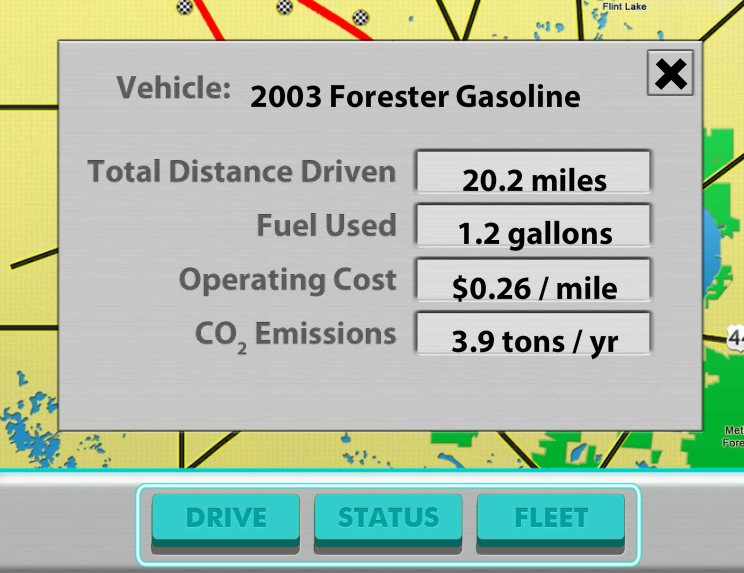
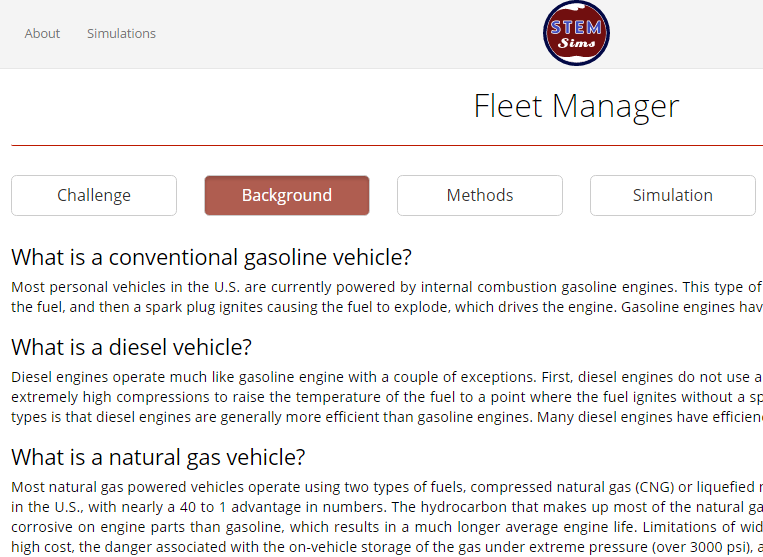
The simulation provides students with a brochure (see link below), a pre-assessment quiz, and an introductory information overview about the use of alternative fuels. The Fleet Manager simulation links important science concepts to real-world concepts. For example, students of all ages can integrate mathematics and science concepts into the decision of purchasing a future car, e.g., mileage, operating cost, emissions, etc.. Hence, this activity gives students the opportunity to evaluate an entire fleet of vehicles. Subsequently, this evaluation elicits the higher levels of Bloom’s Taxonomy and simultaneously challenges students to make both efficient and environmentally decisions similar to those made in real-life.
Brochure: https://stemsims.com/simulations/fleet-manager/brochure/brochure.pdf?version=2017-01-31
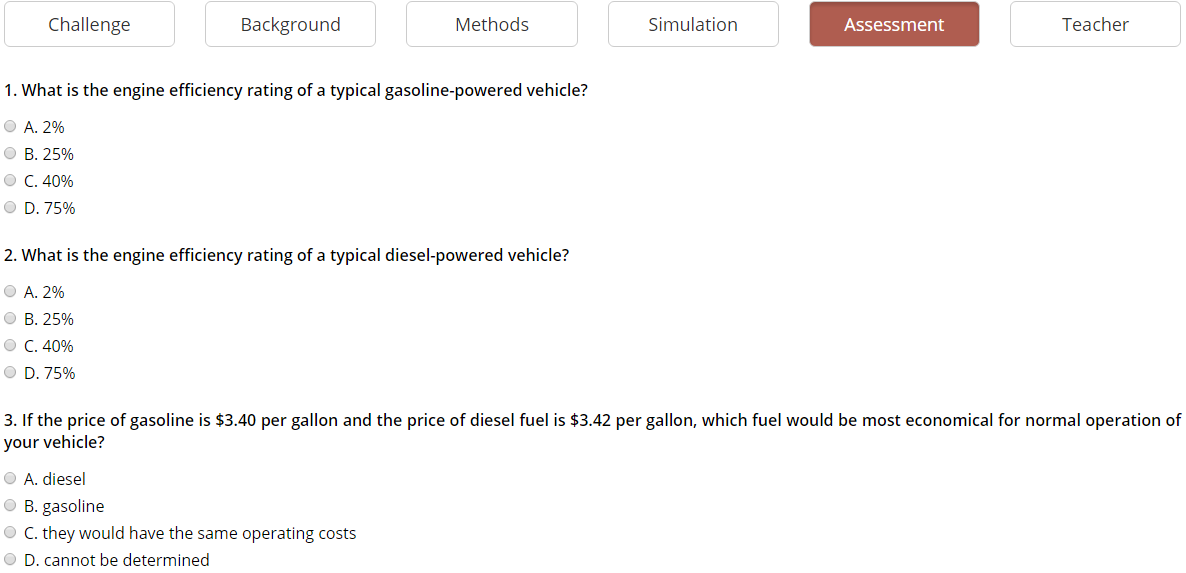
STEM Sims provides three separate lesson plans for this simulation (see links below):
Lesson 1: https://stemsims.com/simulations/fleet-manager/lessons/lesson-1.pdf?version=2017-01-10
Lesson 2: https://stemsims.com/simulations/fleet-manager/lessons/lesson-2.pdf?version=2017-01-10
Lesson 3: https://stemsims.com/simulations/fleet-manager/lessons/lesson-3.pdf?version=2017-01-10
Conclusion
The “STEM Sims: Fleet Manager” simulation engages students into authentic STEM learning at a reasonable cost and standards-based for measurable learning results. Undoubtedly, this simulation is relevant to the scientific concepts that students need to learn and emphasizes environmental concerns and safety. As we have with the other STEM Sims products, consider signing-up for a free trial of this simulation and determine where this instructive learning tool fits into your classroom learning environment.
For a free trial, visit https://stemsims.com/account/sign-up
Recommended System Qualifications:
- Operating system: Windows XP or Mac OS X 10.7
- Browser: Chrome 40, Firefox 35, Internet Explorer 11, or Safari 7
- Java 7, Flash Player 13
Single classroom subscription: $169 for a 365-day subscription and includes access for 30 students and 100 simulations.
Product Site: https://stemsims.com/
Edwin P. Christmann is a professor and chairman of the secondary education department and graduate coordinator of the mathematics and science teaching program at Slippery Rock University in Slippery Rock, Pennsylvania. Anthony Balos is a graduate student and a research assistant in the secondary education program at Slippery Rock University in Slippery Rock, Pennsylvania
STEM Sims: Fleet Manager
Introduction
It’s more than just power, it’s teaching potential: Vernier Go Direct Sensors and Micro USB Charging
By Martin Horejsi
Posted on 2017-04-14
Power powers. It’s that simple. With all our digital tools, there is at least one common thread across it all and that is we need a flow of electrons to keep the teaching and learning in high gear. But of course batteries die. There are four common battery solutions in our digital devices. One is onboard and built-in rechargeable lithium-ion battery packs. Another is a removable lithium-ion battery pack. A third is common grocery store batteries like AA, AAA, and CR2032, among others. And a forth option is some combination and interchangeability of the above. Of course there are hard-wired connection to AC outlets, but those are so limiting that we only use them only for larger devices, static lab-based tools, and those instrument firmly bolted to a desk or other base station.
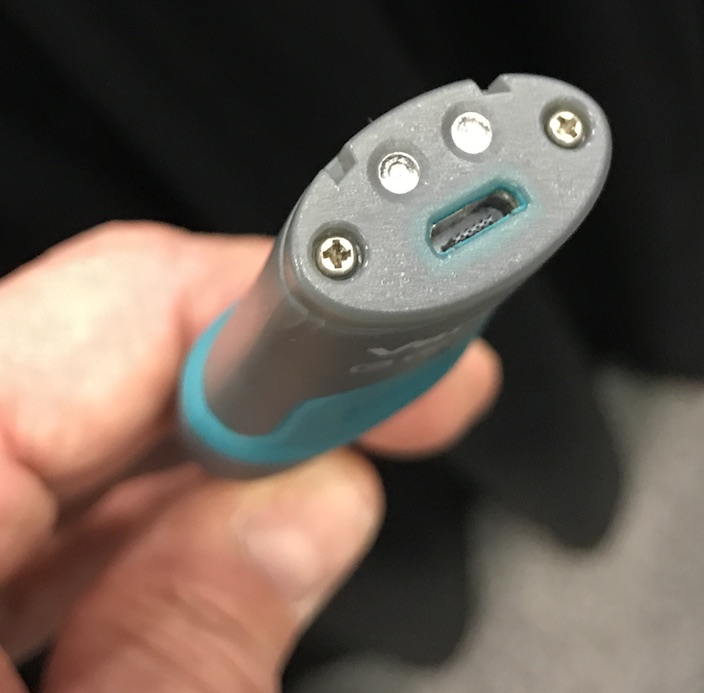
Ahh, but once in the rechargeable realm, a new set of issues can arise. The major factor being the connector required to attach the device to a power source. Way back in the early 2000s and of course earlier, there were many options for connectors. From pin-sized small round connectors, larger round connectors, square connectors, to at least four USB connectors, to proprietary Apple connectors.
In 2009, it almost all changed when a European Commission initiative created a “Common External Power Supply” or EPS that was adopted by almost all major cell phone companies. Notably, Apple was the hold out continuing with their proprietary 30-pin connector, and more recently their Lightning connector.
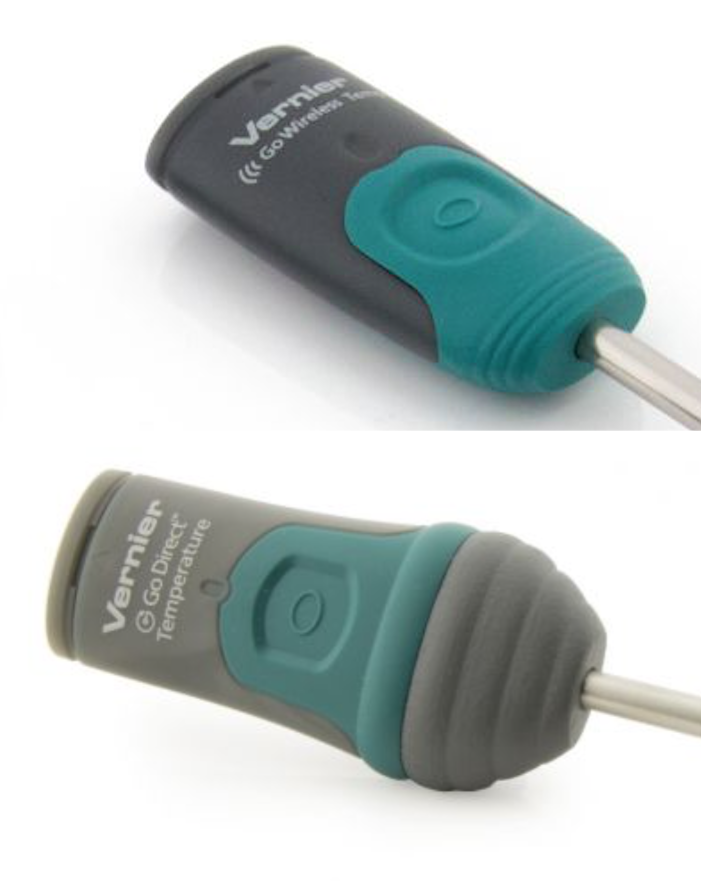
Companies that made other devices slowly adopted the industry standard using the Micro USB port standard for power and recharging. A slightly larger connector, the Mini USB port, was a common go-to connectors, but had little advantage over the micro USB except for port orientation directionality (it was easier to tell which way to orient the cable), and a slightly overall connector strength when under cable stress.
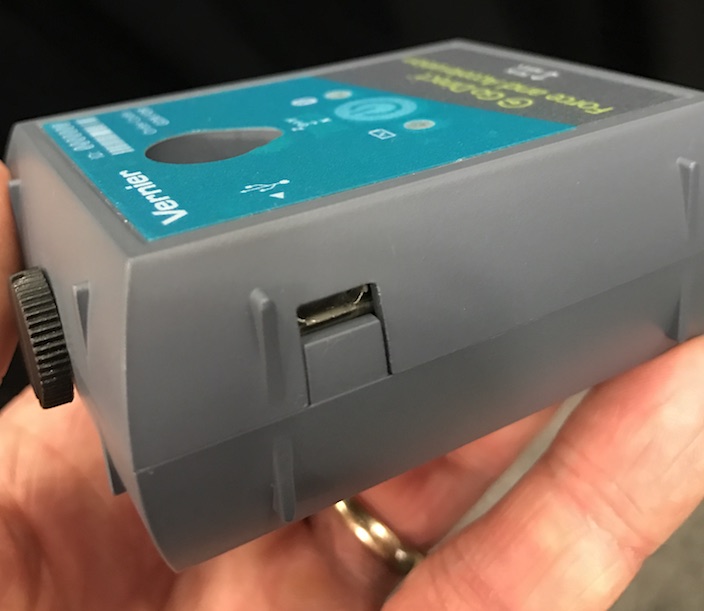
Vernier Technologies, creator of some the most innovative and useful digital sensors, probes, and software used its own proprietary connector design for it’s Go Wireless line of sensors. But this year, it has added the Common External Power Supply connector to its sensors that contain internal lithium-ion batteries and other upgrades calling the new sensor line Go Direct. The micro USB port provides three distinct advantages over anything proprietary. First, it is a common connector in both the sense that many devices use it, and common there are many options for power supplies when using the micro USB.

In the past, many of use had bins, boxes, drawers, or bags filled with various charging cables all hardwired to specific connectors. I remember once vowing to myself that I would never buy a certain brand’s product because the required cable was not only proprietary but also seemingly excessively expensive for a simple cable. It was maddening to pay upwards of $40 for a small cable that only worked with one specific device. When I did the mental math, the cable cost about one-fifth of the entire device. How could that be?

Even today, I am not free of cableage. In my go-bag for conference presentations, I carry cables for USB-A, B, and now C, Ethernet, VGA, HDMI, 30-pin Apple, Lightning, Firewire, and 3.5mm audio, and a Class C C7 power connector. And soon missing from my cable carry will be the Vernier cradle for its Go sensors.
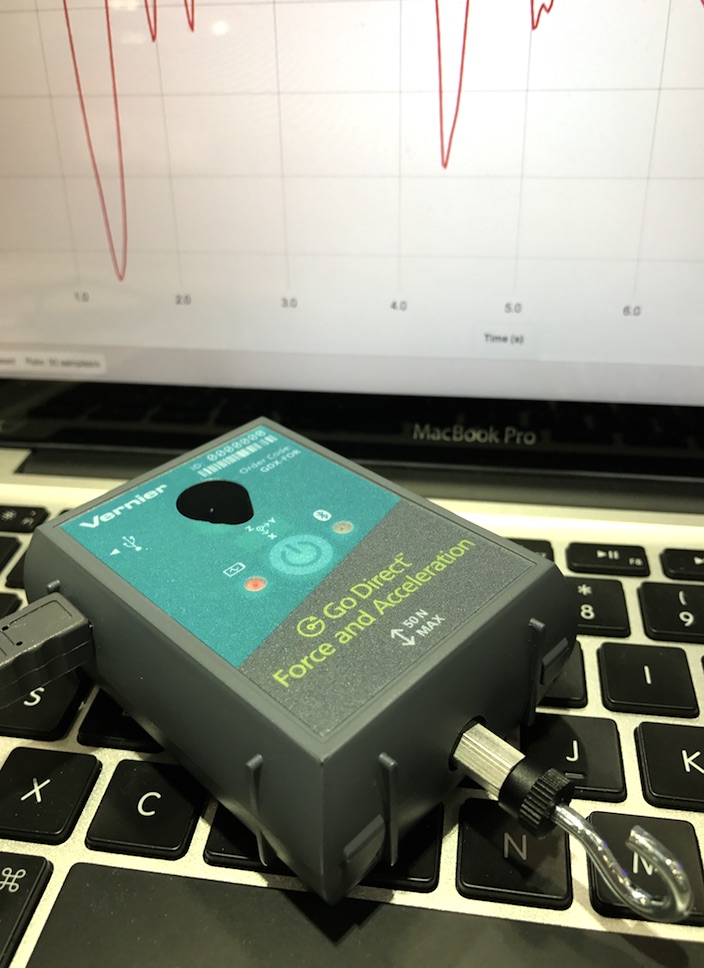
Labs just got simpler. Vernier Technologies has added the micro UBS port to its Go Sensors. So now the new version of it’s sensors can recharge using both the traditional Vernier Go sensor charging cable and dock, as well as a universal micro USB port. This is a welcome addition since on more than one occasion I have been out in the field in need of a charge but without a handy Vernier proprietary charging cradle. Further, like smartphones, the data collection can continue with an external battery attached leading to the potential of literally unlimited data collection times due to the limitless and unlimited supply of electrons that can be piped into the sensor’s on-board lithium ion battery. Whether solar, hydro, or coal-fired, the electrons can flow. They can even flow from plenty of portable solutions that recharge our devices including my favorites that draw electrons from my high capacity power tool batteries including the Milwaukee Tools 12 volt and 18 volt FUEL battery options.
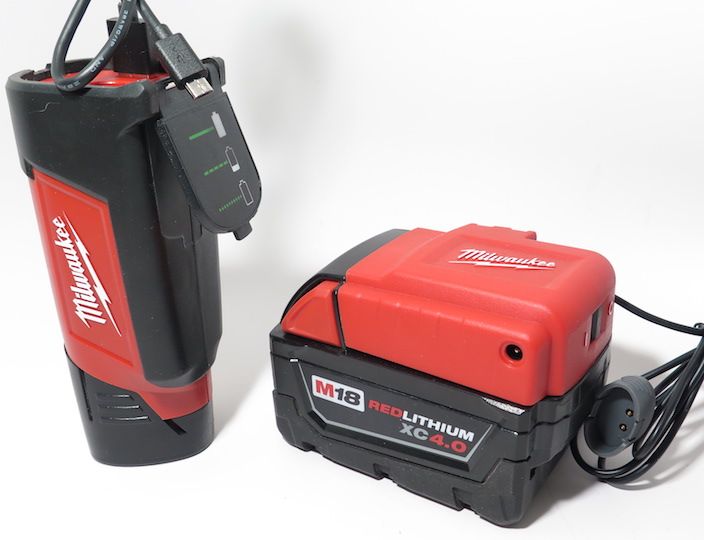
Replaceable batteries have some advantages in that they can be replaced when needed, but they do require an interruption in activity while the batteries are swapped. A second problem is that a battery discharges with use so often we head into the next class or teaching day with used batteries. We might have a pocketful of new batteries, but swapping out batteries with some charge left is not easy for a teacher on a limited budget. So enter the on-board rechargeable.

When a rechargeable is built into the device and recharged on the fly especially when in use, the advantage is tremendous. Every science class can have fresh full batteries, and if the data collection pushes up against the capacity of the battery, it can be charged while in use without data collection interruption. And this goes for cell phones, cameras, sensors, and lights.

So until we have onboard power generation from solar cells or mini-nuclear plants, we will have to be happy with common-connector recharging of onboard power with our science teaching tools. And a more powerful cable than the standard DC two-lead cable provides a chance to connect to a computer and stream data independent of a wireless connection. Vernier’s new line of Go Direct sensors are yet another step in the right direction of unlimited teaching potential. Stay tuned for more on the individual sensors and probes.
Power powers. It’s that simple. With all our digital tools, there is at least one common thread across it all and that is we need a flow of electrons to keep the teaching and learning in high gear. But of course batteries die. There are four common battery solutions in our digital devices. One is onboard and built-in rechargeable lithium-ion battery packs. Another is a removable lithium-ion battery pack. A third is common grocery store batteries like AA, AAA, and CR2032, among others.
Why should you attend the 6th Annual STEM Forum & Expo?
By Korei Martin
Posted on 2017-04-14
Why should you attend the 6th Annual STEM Forum & Expo this July? As Chairperson of this event, I think all STEM educators should join us in Kissimmee, Florida from July 12 – 14, 2017, for this premier, international professional development event. The conference committee and NSTA staff, in collaboration with our program partners, have worked diligently to bring you, our attendees, a world class event that will bring together all stakeholders in STEM education while showcasing cutting edge research and best practices in STEM education and workplace development.
Looking for the most rigorous and relevant information for your established STEM program? Is your institution at the infancy of STEM? Do you need guidance on how to start STEM in your own classroom? The STEM Forum & Expo brings together the top thinkers and organizations in STEM education in one location. This three day event provides you with the latest information on STEM content, teaching strategies, and research to enhance and expand your professional growth. You will be able to select from over 400 strand specific sessions, seminars, and featured panel discussions, while collaborating with leaders in STEM education and national education policy makers. In addition, you are able to network and start collaborations with colleagues from around your area and from around the world through face-to-face interactions, back channel discussions, and social events. It does not matter if you are just starting a STEM program or looking to further develop your present STEM program, the STEM Forum & Expo has learning opportunities for all.
Through our unique strand approach that is divided up by grade levels, administration, and partnership strands; attendees will be able to easily follow a specific track of sessions and panels to increase their pedagogical knowledge and to become more reflective and effective educators. Below are just a few examples of the programming you will experience when you attend the 6th Annual STEM Forum & Expo:
- Hands-on sessions that enhance ongoing development of teachers and school leaders to improve their STEM knowledge, as well as their pedagogical skills used to import the specialized knowledge/content in each of the STEM disciplines.
- Specialized panels that promote the implementation of teacher and administrator skill and competency development, including data-informed teaching and leading, and the integration of research-based methods into the STEM curriculum.
- Networking opportunities for administrators to improve and enhance competencies attributable to strong STEM leadership, including, but not limited to, supervising and motivating staff, coordination of STEM curriculum, promoting and sustaining a positive school learning climate, and evaluating student performance in the STEM disciplines.
- The forum provides project- and research-based activities that tackle issues of real-world relevance. Our programming is driven by the latest research in subject areas as well as best practices for communicating topics in effective and meaningful ways.
- A STEM specific exhibit hall with the newest tools and resources to assist you with educating our students in STEM.
I am most excited about the new features to this year’s STEM Forum & Expo that brings together new groups under our growing STEM umbrella:
- Inclusiveness and Equity – We are thrilled to have new panel for this year called “Engaging Diverse Learners and Special Needs Students in STEM.” Hosted by Janella Watson, Director of the Providence Children’s Museum, this panel will help us and our diverse learners navigate STEM. This panel will demonstrate how the best STEM teachers believe in the capacity of all of their students to learn and how they carefully utilize a range of pedagogical approaches to ensure this learning occurs.
- Informal Education in STEM – Another new panel to this year’s STEM Forum is “Shift Makers: How Informal Educators are making a shift to better support STEM and Learner-Centered Science.” Hosted by Karen Hays, Youth Program Manager at the Denver Zoo, this panel will advise attendees on how informal environments are ideal for STEM learning as well learner-centered interests and curiosities in STEM. Come learn about the resources these informal education centers offer to schools and to your classrooms.
- STEM Magic at the Magic Kingdom® – We are thrilled that the Walt Disney World Resort® and Disney Youth Education Services is offering a special STEM-tastic post-conference event for 150 of our attendees at the Magic Kingdom Park ® on Saturday, July 15th. The “Energy and Waves” workshop will feature hands-on activities that form the foundation of your exploration of sound and light at work at the Magic Kingdom® Park.
- Invigorating and High Energy Keynote Speaker – We are overjoyed that Derek Muller will be joining us as this year’s keynote speaker for the STEM Forum. Derek is an engineer, physicist, filmmaker, science educator, and founder of You Tube’s widely popular science channel Veritasium and his new channel Sciencium.
As you can see there are many reasons why you should attend the 6th Annual STEM Forum & Expo! On behalf of the steering committee and NSTA, we hope to see you in the Kissimmee, Florida this July! We promise it will be an invigorating, rewarding, energizing, and magical experience for you as we dive deeper into STEM and prepare for a new school year. See you there!

Jennifer Williams is in her eighteenth year of teaching STEM at the Isidore Newman School in New Orleans. As the Lower School Science department chair and STEM Coordinator, she provides leadership in the development of quality instruction within the Lower School STEM program for grades Pre-Kindergarten through 5th.
The mission of NSTA is to promote excellence and innovation in science teaching and learning for all.
Future NSTA Conferences
2017 STEM Forum & Expo
Kissimmee/Orlando, July 12–14
2017 Area Conferences
Baltimore, October 5–7
Milwaukee, November 9–11
New Orleans, Nov. 30–Dec. 2
Why should you attend the 6th Annual STEM Forum & Expo this July? As Chairperson of this event, I think all STEM educators should join us in Kissimmee, Florida from July 12 – 14, 2017, for this premier, international professional development event.
Ed News: NM Governor Vetoes Bill To Set New Science Standards In State Law
By Kate Falk
Posted on 2017-04-14

This week in education news, New Mexico governor vetoes a measure to force the adoption of new state science standards; New Hampshire rejects new education commissioner’s proposal to reconsider the state’s science standards; Idaho education leaders hear comments on science standards; top Democrats condemn climate change skeptics for targeting teachers; and Oklahoma panel advances bill critcized as threat to science education.
Susana Stops Science Standards: Governor Vetoes Bill To Set New Science Standards In State Law
To the surprise of no one who’s been following the long, winding road to updating the science taught in New Mexico’s schools, Gov. Susana Martinez vetoed a measure designed to force the adoption of new standards. House Bill 211 would have required the state to adopt the Next Generation Science Standards, nationally vetted benchmarks for teaching public school children science from K-12. Click here to read the article featured in the Santa Fe Reporter.
New Hampshire State Board, Edelblut Clash On Science Standards
When New Hampshire Education Commissioner Frank Edelblut was appointed to his post in January, the politician assured critics that whatever his personal beliefs, he would consider himself “the implementation guy” for an agenda largely dictated by others. In response to a question by Democratic Executive Councilor Andru Volinksy regarding whether he would object to local schools teaching creationism in their science curriculum, Edelblut called his point of view “irrelevant.” And at a recent State Board of Education meeting, the commissioner was sharply reminded of his circumscribed role when the State Board of Education unanimously rejected his proposal to reconsider the state’s science standards. Click here to read the article featured in the Concord Monitor.
For Science Educators, The Stakes For Teaching The Next Generation Feel Higher Than Ever
Paul Reyna, now in his 28th year as a teacher, was among the many attendees of this year’s national conference of the NSTA, the world’s largest professional organization representing science educators of all grade levels. Reyna credits his family with his decision to become a science educator, but the Texan says that it’s professional development, like the NSTA’s conference, that has been key to his success. Click here to read the article featured on PBS NewsHour.
Idaho State Ed Leaders Hear Comments On Science Standards
On Tuesday night in Twin Falls, the Idaho Department of Education held the first in a series of six public meetings across the Gem State to gather feedback from educators, parents and community members. Proposed changes to science standards drew controversy and debate during the legislative session — particularly, about climate change. Click here to read the article featured in Atchison Globe Now.
Democrats Condemn Climate Change Skeptics For Targeting Teachers
Three top Democrats have urged a libertarian think tank to stop mailing climate change skeptical classroom materials to teachers across America. The ranking Democrats on the House committees overseeing education, natural resources and science condemned the group’s mass-mailing campaign and counseled teachers to throw away the materials when they arrive. Click here to read the article featured on PBS FRONTLINE.
Oklahoma Panel Advances Bill Criticized As Threat To Science Education
A House panel narrowly approved legislation that would protect teachers who help foster discussions about scientific controversy. Opponents of Senate Bill 393 believe it could let teachers promote unproven theories, giving credence to topics like creationism, climate change denial, or as one parent said, ancient aliens. Click here to read the article featured in The Oklahoman.
New Science Standards Raise Hopes For Narrowing Achievement Gap
As California rolls out new K-12 science standards, some educators believe the new curriculum will spark a love of science and boost test scores among African Americans and Latinos, and ultimately lead to a more diverse STEM workforce. Click here to read the article featured in EdSource.
Stay tuned for next week’s top education news stories.
The Communication, Legislative & Public Affairs (CLPA) team strives to keep NSTA members, teachers, science education leaders, and the general public informed about NSTA programs, products, and services and key science education issues and legislation. In the association’s role as the national voice for science education, its CLPA team actively promotes NSTA’s positions on science education issues and communicates key NSTA messages to essential audiences.
The mission of NSTA is to promote excellence and innovation in science teaching and learning for all.
Follow NSTA

Ideas for science "camp"
By Mary Bigelow
Posted on 2017-04-13
 I’ve been asked to teach a voluntary summer enrichment science class for 20 upper elementary students. I can determine the content and structure for the class. I have a modest budget, access to the science resources in the school, and the principal will assist with logistics. I’ve never done this before, so I’m looking for ideas and suggestions. —T., Ohio
I’ve been asked to teach a voluntary summer enrichment science class for 20 upper elementary students. I can determine the content and structure for the class. I have a modest budget, access to the science resources in the school, and the principal will assist with logistics. I’ve never done this before, so I’m looking for ideas and suggestions. —T., Ohio
Having an uninterrupted block of time to focus on science sounds like a wonderful experience for you and your students.
Many summer programs call themselves a “camp” to differentiate from remedial classes. Rather than a series of unconnected activities, you may want to pick themes that you are interested in, too–for example
- Nature study (plants, insects, stream study, trees, birds),
- Engineering/design (rocketry, wind power, inventions),
- Earth science (rocks, fossils, weather), or
- Community service (gardening, recycling).
The March 2017 issue of Science and Children features ideas for getting students outside. “Our Oasis” describes how high school students can be mentors in an elementary summer camp. The article also has examples of activities and schedules. Look at what science and nature centers offer as summer programs for more ideas. Perhaps you could do relevant activities and investigations that are too time-consuming during the school year.
Provide opportunities for students to be outside and active (with backup plans for rainy days). Include photography and journaling for students to document what they are doing and reflect on their learning.
Work with your principal on the details: safety and first aid, other adults to assist, permission slips, possible fees, transportation, refreshments/lunch, and the possibility of visiting off-campus sites, such as museums or parks.
Ask students and parents for an evaluation of the program to assist with future planning.
Most of all – enjoy!
Photo: https://www.flickr.com/photos/housebear/1435962367/
Robert E. Yager Excellence in Teaching Awards — 2017 winners
By admin
Posted on 2017-04-12
This award recognizes excellence and innovation in the field of science education. This award acknowledges teachers who share Robert Yager’s passion for education and continued professional development. This award also honors Robert Yager’s effort to make excellent science education accessible to students of the 21st century and beyond. Awardees will have exhibited excellence and innovation in the field of science education, and embody the mission statement of NSTA. Six awardees will be selected annually.
The individual awardees will receive a $1,000 award, up to $1,000 for travel expenses to attend the NSTA National Congress on Science Education, and a plaque. They will be asked to present at the NSTA National Congress on Science Education, with their presentation videotaped for future use. The awards will be presented during the NSTA National Congress on Science Education, held each summer. An identified Yager Scholar from the six awardees will be given additional support up to $1,500, to present at a future NSTA National Conference on Science Education.

Yager Scholar and District XII – Kristin Rademaker
Science Teacher
Harlem High School
Machesney Park, IL
Teaching through phenomena allows to engage her students and get them figuring out the science behind what happened, sparking natural curiosity to figure things out. Once the phenomena is introduced she uses the science practices and other strategies that allow students to dig into what they know, figure out what they don’t know, and fix the things they thought they knew. Rademaker focuses on students learning science through working together, solving problems, making mistakes, embracing them, and trying again. Teaching through phenomena also allows her to implement a number of different teaching methods depending on the task at hand. Using strategies that get the students active and engaged have been instrumental in changing the culture of her classroom. Engaging students through productive talk turns her classroom into a student-driven learning environment. Along with using productive talk, she also uses gallery walks, small- and whole-group discussion, close reading, driving question boards, and claim evidence reasoning along with many others. These methods coupled with the science and engineering practices not only provide students with opportunities for engagement but also allow them to develop valuable skills they can use across all academic areas and beyond. “I have come to see Mrs. Rademaker as a transformative leader in science education that I wished every science teacher in our country could meet someday and learn from,” says Michael Novak, Instructor, Northwestern University.
District I –Steven Autieri
–Steven Autieri
Science Teacher
Suffield Public Schools
Suffield, CT
Steven Autieri has been involved in developing and instructing courses centered on the theme of blended instruction, which is a computer-mediated instructional strategy that permits students to complete essential tasks at their own pace. Autieri has also served as a contributing member of a school blended learning implementation team, which provided professional support to building staff and has coordinated learning walks to highlight implementation of technology in the classroom.He inspires fellow colleagues to adopt these strategies in their own classrooms by sharing with them developed resources, lessons, and assessment strategies that will help them to be successful in driving student learning. Autieri has been deeply involved in the professional development of and discourse with other educators in his own district, as well as with teachers across the state through a workshop conducted on blended instruction delivered at the 2013 annual meeting of the Connecticut Computer Educator’s Association (CECA). According to Maria Pompano, Science Instructional Leader, East Haven High School, “Steve’s enthusiasm, innovativeness, and genuine concern for the students at our school were exemplary. He was a teacher leader, a role model, and an asset in the building as well as in the greater community of science teachers in Connecticut.”

District VI – Covey Denton
Science Teacher
Greenfield School
Wilson, NC
Covey Denton’s students begin a science unit with immediate engagement and a fun activity. While always ensuring that the true science behind the fun is learned, Denton uses multiple modalities to reach her students. She uses hand motions and moving bodies to explore. She raps, sings songs, and claps rhythms to help those who are auditory learners. Denton encourages students by proposing STEM design challenges, letting students develop and test their own lab ideas, and offering a student choice project to her fifth and sixth graders for every unit. Denton’s homework assignments include creating a story about the rock cycle, told from a rock’s point of view or having students write their own comic book adventure about science topics. Her love for science is infectious and quickly spreads from her to her students. “Ms. Denton has brought so much energy and enthusiasm to her lower and middle school science classes. She has a terrific knowledge of the sciences taught in our school and continually works to make it interesting, fun, and educational. Students are not just learning science, they are DOING science. They are all over campus taking and testing soil samples, examining the water in our pond on campus while learning about water pollution and the effects of runoff from our soccer field, or examining our small ecosystem along our nature trail,” says Beth Peters, Head of School, Greenfield School.

District VII – Kristen Sumrall
Science Teacher
Lafayette Middle School
Lafayette, MS
Kristen Sumrall has three questions she asks when preparing for a new year of science instruction. “How can I motivate my students to want to learn science? How can I convince my students to like/enjoy the world of science? And, how can I convince ALL my students that they can be successful at doing science?” She uses these three goals and questions as the driving force in how she develops curriculum as well as how she teaches science. Three of her favorite science teaching methods are open inquiry, problem based learning, and use of the 5E model, which have been effective in helping her motivate and convince her students that they can be successful at doing science. She uses the NGSS and state standards as the driving forces in the development of lessons and in her instruction. She believes that the purpose/relevancy of science to the world as identified in the NGSS is an important aspect of why and how we teach science. “Kristen is grounded in research-based practices. She has breadth and depth of scientific and educational research knowledge beyond her professional years of experience. She is an innovative science educator and a remarkable leader. She models professionalism and excellence in everything she does but especially in how she motivates others and brings forth the best in everyone,” says John Ammons Professor, Mississippi Delta Community College.

District XIII – George Hademenos
Physics Teacher
Richardson High School
Richardson, TX
To ensure that his lessons are presented from the student perspective, George Hademenos designs each lesson so his students do not hear and write about the discussed concepts or topics but that they see and experience them. Hademenos has been known to wear high-heeled shoes to illustrate the concept of pressure, use a bowling ball pendulum to illustrate the concept of friction, launch a pill bottle rocket using a PVC pipe launching pad and a bicycle pump, and launch high-altitude weather balloons to see and understand science 100,000 feet above the Earth’s surface. Students could describe characteristics of his teaching style by saying words like animated, expressive, emotive, and loud. Violetta Espinoza, former student, states that Hademenos “is capable of giving lessons that are understandable, with some humor on the side to keep people engaged. Most of all, however, he does an amazing job at helping students reach their academic goals.” Hademenos loves to show his students how excited he is about physics because chances are good that if he’s excited about something, the students will also be excited about it. “Dr. Hademenos is a teacher that is not content with the daily responsibilities of lecture, labs, and tests. He is always looking for opportunities to bring practical examples of his subject into the classroom,” says Charles Bruner, Principal, Richardson High School.
 District XVIII – Ruggero Racca
District XVIII – Ruggero Racca
Science Teacher
Toronto District School Board
Toronto, Ontario, Canada
Ruggero Racca’s work as a teacher situates itself at the convergence of three pedagogical stances: interdisciplinary learning, transformative learning, and inquiry-based learning. Interdisciplinary learning provides his students with authentic experiences in more than one content area, offering them a range of learning experiences, and giving them choices in the projects they pursue and the ways they demonstrate their learning. His students engage in journal writing, metaphors, life history exploration, learning contracts, group projects, role play, case studies, and using literature to stimulate critical consciousness as pathways to transformative learning. Students use open-ended investigations into a question or a problem, engaging in evidence-based reasoning, problem finding and problem solving. In this rich context, and through the use of gradual release of responsibility, students in his class acquire transferable, lasting inquiry skills and the ability to apply them across the curriculum in examining and challenging their own expanding knowledge. “The inquiry model Ruggero perfected in his classroom has been the focus of observation and broader implementation by the Toronto District School Board (TDSB), as well as by the Ontario Ministry of Education. In his teaching, Ruggero nurtures not only highly effective science learning, but also a deepening of the students’ empathy towards, and connection with, the world around them,” says Catherine Munro, Vice Principal, Cosburn Middle School.
This award recognizes excellence and innovation in the field of science education. This award acknowledges teachers who share Robert Yager’s passion for education and continued professional development. This award also honors Robert Yager’s effort to make excellent science education accessible to students of the 21st century and beyond. Awardees will have exhibited excellence and innovation in the field of science education, and embody the mission statement of NSTA. Six awardees will be selected annually.
Safety Blog
Making a Checklist for Safer Labs
By Kenneth Roy
Posted on 2017-04-11
A lab safety checklist can serve as a map to help science teachers navigate through safer waters.
The list not only makes labs safer for students but also fulfills part of the teacher’s legal responsibility for inspecting, securing, and maintaining a safer learning space. For school districts regulated under the Occupational Safety and Health Administration (OSHA), the list needs to reflect fundamental elements of the Laboratory Standard and Hazard Communication Standard. Non-OSHA regulated school districts need to incorporate state and local safety regulations for academic labs into their lists. OSHA’s webpage contains safety and health standards and regulations specific to each state.
The following checklist addresses most—but not all—situations in K–12 science laboratories, but it can be tailored to meet the needs of individual laboratories.
Environmental health and safety
• Is there an active environmental health and safety program (e.g., chemical hygiene plan) addressing management of biological, chemical, and physical hazards specific to your work-site?
• Is there a person designated for the implementation and enforcement of the safety program (e.g., chemical hygiene officer)?
• Is there a department or school safety committee composed of employees and employers that meet regularly and write reports on their activities?
• Is there a process for handling employee complaints regarding environmental health and safety issues? To give an example, employees can submit a reporting form to their supervisors to address safety issues. Employees can also file a confidential complaint with OSHA to have their workplace inspected.
Personal protective equipment
• Is there a process to determine whether activities contain hazards requiring the use of personal protective equipment, or PPE (e.g., head, eye, face, hand, or foot protection)? This process involves three steps: hazards analysis, risks assessment, and safety action. Once risks are assessed after the hazards analysis, the safety action would determine which types of PPE are required for a safer activity.
• If hazards are found, are employers, employees, and students using the proper PPE?
• Are indirectly vented chemical splash goggles worn where there is a danger of flying particles or corrosive materials?
• Are safety glasses worn where there are solids hazards such as projectiles and meter sticks?
• Are employees and students who have glasses or contacts required to wear approved safety glasses, protective goggles, or use other precautionary procedures such as eliminating the use of contacts.
• Are there gloves, aprons, shields, or other protection for employees and students to protect themselves against hazards such as corrosive liquids, sharp objects, and chemicals?
• Is all protective equipment well maintained and ready for use?
• Are there eye wash facilities and a drench shower within the work areas that contain hazardous chemicals or biologicals?
• Are food and beverages consumed in areas where there is no exposure to hazards?
Flammable and combustible materials
• Are approved containers and tanks used for storing and handling flammable and combustible liquids? Containers or tanks for such storage or handling must meet OSHA’s Flammable Liquid standard and have labeling noting that it meets the standard.
• Do storage rooms for flammable and combustible liquids have explosion-proof lights and mechanical or gravity ventilation?
• Are fire extinguishers for combustible; liquid, gas, or grease; and electrical equipment fires placed in the appropriate areas?
• For electrical equipment fires:
- are appropriate fire extinguishers mounted within 75 ft. (23 m) of outdoor areas containing flammable liquids and within 10 ft. (3 m) of indoor storage areas?
- are extinguishers free from obstructions or blockage?
- are all extinguishers serviced, maintained, and tagged each year?
- are all extinguishers full and in their designated places?
Working surfaces
• Are all work-sites clean, sanitary, and orderly?
• Are work surfaces slip-resistant?
• Are all spilled hazardous materials or liquids, including blood and other potentially infectious materials, cleaned up immediately according to proper procedures?
• Is all regulated waste, as defined in the OSHA bloodborne pathogens standard (1910.1030), discarded per federal, state, and local regulations?
• Are aisles and passageways kept clear?
Hazard communication
• Is there a current inventory of hazardous substances in your workplace?
• Is there a written hazard communication program dealing with safety data sheets (SDSs), labeling, storage, disposal, and employee training?
• Is each container (i.e., vats, bottles, storage tanks) for a hazardous substance labeled with product identity and hazard warning information?
• Is an SDS readily available for each hazardous substance at the work-site?
• Is there an annual employee training program for hazardous substances?
• Does this program:
- explain what an SDS is, and how to use and obtain one?
- include SDS contents for each hazardous substance or class of substances?
- explain “Right to Understand?”—that is, understand how to work with hazardous chemicals in a safer way.
- identify where an employee can see the written hazards communication program and where hazardous substances are present in their work areas?
- note the physical and health hazards of substances in the work areas and specific protective measures?
- provide details of the hazard communication program, including how to use the labeling system and SDSs?
• Are employees trained to:
- recognize tasks that might result in occupational exposure? Occupational exposure refers to anticipated bodily contact with chemical hazards and toxic substances.
- use engineering controls, PPE, and to know their limitations?
- obtain information on the types, selection, proper use, location, removal, handling, decontamination, and disposal of PPE?
- know who to contact and what to do in an emergency?
Meeting OSHA’s Laboratory and Hazard Communication standards
• Are there safety engineering and administrative controls, including standard operating procedures?
• Are there criteria (e.g., proper housekeeping) for implementing and inspecting specific controls?
• Is there annual testing and certification of fume hoods?
• Is there access to information and training requirements?
• Are there laboratory operations that require approval of the employer or chemical hygiene officer? For example, the use of a new hazardous chemical might require the pre-approval of the chemical hygiene officer.
• Are there provisions for medical consultation and exams?
• Is there a designated chemical hygiene plan?
• Is there a chemical hygiene officer?
In the end
A good place to start a safety inspection is by answering the questions on the checklist, which provides a viable safety assessment and improves safety in the learning environment.
Submit questions regarding safety in K–12 to Ken Roy at safesci@sbcglobal.net, or leave him a comment below. Follow Ken Roy on Twitter: @drroysafersci.
NSTA resources and safety issue papers
Join NSTA
Follow NSTA
A lab safety checklist can serve as a map to help science teachers navigate through safer waters.


